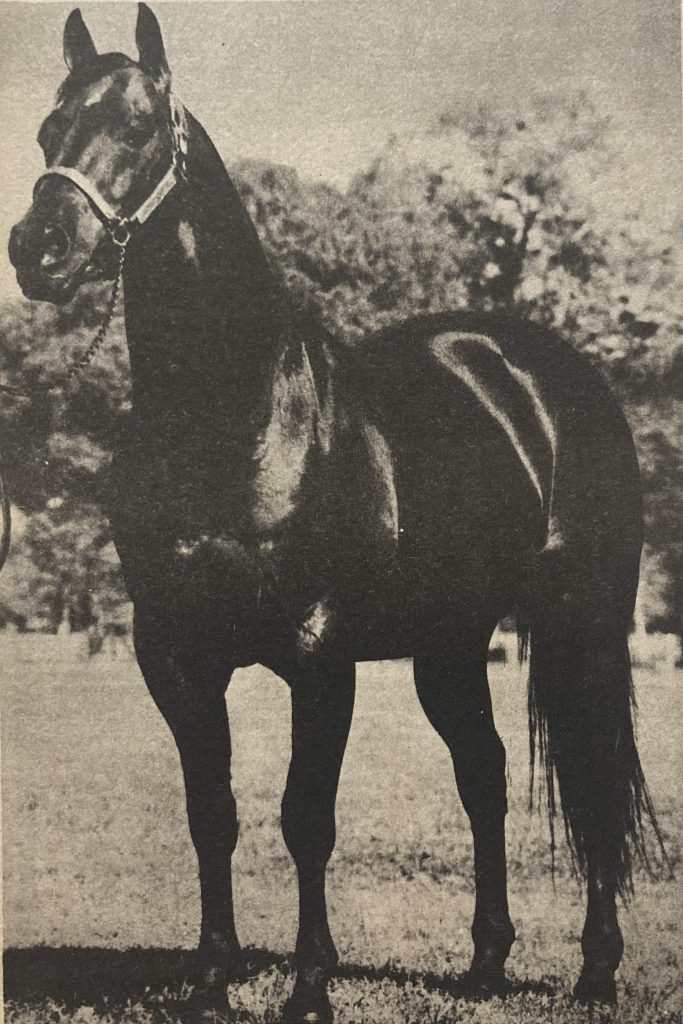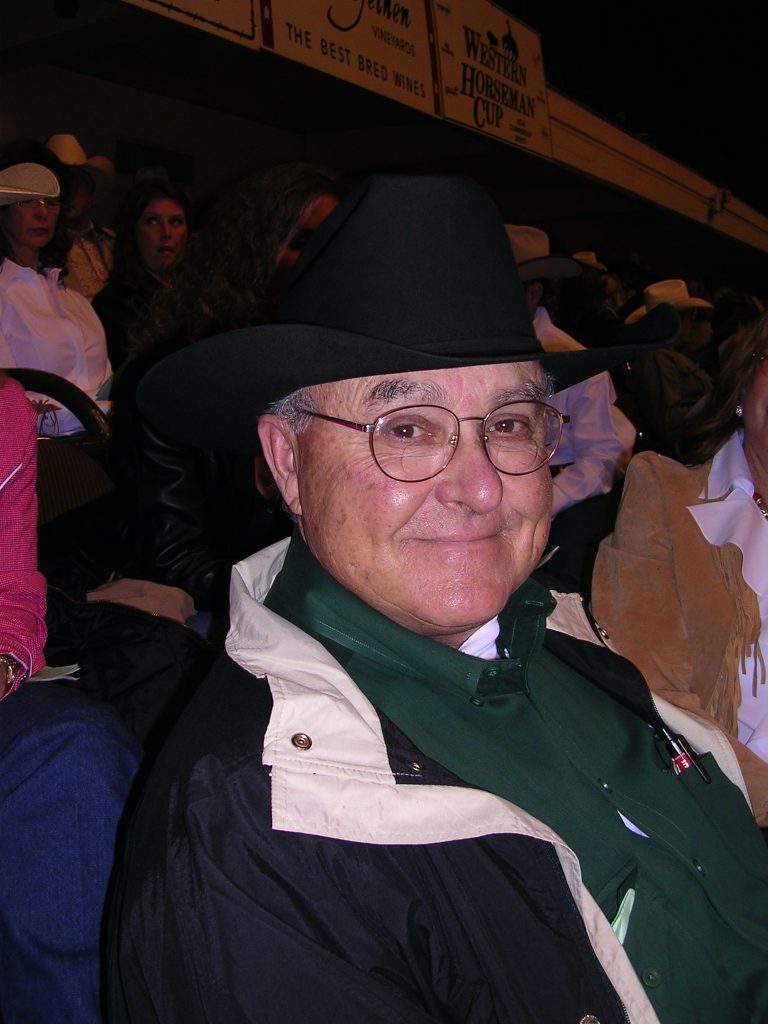Cal Bar: From Champion Stock Horse to Champion Cutting Horse
The following article about Cal Bar was originally published in Quarter Horse News on May 5, 1980.
Usually when a stallion receives his “championship” status, and he’s 7 years old, he’s retired to stud. At that stage in his life, he’s usually too valuable an animal to “haul down the road”.
That may be the thinking of in many horsemen — but not one very determined horseman — Pete Mattioli, owner of the Double Bar M Ranch, Santa Rosa, California.
When Pete bought Cal Bar in 1973 from Arnold Dolcini, Jr. of Petaluma, California (the owner of Teresa Tivio), who had owned the then 7-year-old stallion for several years, Cal Bar had already established himself with a very respectable record in stock horse classes in California.
Foaled in 1966, the son of Doc Bar out of Teresa Tivio, a daughter of Poco Tivio, Cal Bar had won honors as the 1970 California Reined Cow Horse Association (CRCHA) Champion Hackamore Horse, the 1971 CRCHA Champion Stock Horse, the 1972 CRCHA Champion Stallion, the 1973 Reserve World Champion Stock Horse and the 1973 Reserve World Champion All-Around Horse. Up to this time, Cal Bar had never been either trained or shown as a cutting horse.
 Doc Bar * QHN File Photo
Doc Bar * QHN File Photo
Pete Mattioli, whose main livlihood at the time was the restaurant business, recalls, “When we told people we were going to put him (Cal Bar) in cutting, quite a few people laughed at us. They thought he’d never make a cutting horse.”
Mattioli, who has only been in the horse business since about 1971, realized that to get into the horse business and do it successfully, he needed some help… the right ranch manager, the right trainer and most important of all, the right horse. Mattioli was lucky enough to find all three. Rich Gimondo, ranch manager for Mattioli, has certainly been an asset to the operation, as was the young trainer he hired — Larry Reeder.
Fresh from an internship with Matlock Rose, Larry had moved to California and helped Mattioli pick out the “right” horse — Cal Bar.
After Cal Bar was purchased, the question was, “Would he make a cutting horse?”
“After the second or third time I ever rode Cal Bar and worked him on a cow, I told my wife that it I could get him relaxed and get him under control, that he’d be a great cutting horse,” reminisces trainer Larry Reeder. “And I never went through a period of my training with that horse when I doubted that. I felt like he was a great, and I showed him to a lot of people from time to time when I was training him, but very few people saw his capabilities, because they weren’t seeing a whole picture. The horse had a tremendous amount of ‘move’ to him and he did things very rapidly with a cow, but he was wild and they just couldn’t see that he’d ever be under control.”
 Cal Bar * QHN File Photo
Cal Bar * QHN File Photo
After seven months of training, Larry felt Cal Bar was ready to show.
“At that first cutting, I think I marked a 70 on him and he was out of the money. Then about four days later, we went to Portland, Oregon and in the first go-round, it seemed like there were 37 or 38 horses in the Open Class that day. I marked 74 on him and split second and third. The second go at that same show, I marked a 74 1/2 and that won the second go. I also showed him in the $1000 Novice and I marked a 73 1/2 on him in the first go and in the second go I marked a 74. That won both go’s in the Novice Class. And so in that one day, the second cutting he’d ever been to, I won a little over a thousand dollars on him,” said Larry.
From then on, Cal Bar’s cutting record is history. He was named the 1974 Pacific Coast Cutting Horse Association (PCCHA) Champion Novice Cutting Horse, the 1974 PCCHA Champion Open Cutting Horse and finished the year fifth in the nation in the National Cutting Horse Association standings. In June of 1974, he received his AQHA Register of Merit in the Cutting and Working Cow Horse Categories. In 1975, he received his NCHA Certificate of Ability and in 1977 received the NCHA Bronze Award. He was inducted into the Cow Horse Hall of Fame in 1979 — the youngest horse to be entered. According to Reeder, there’s never been another horse on the Pacific Coast that won the Open and Novice the same year.
Before Mattioli purchased him, Cal Bar had sired very few colts, but after his explosion into the cutting world in 1974, Cal Bar was retired to stud as a 9 year-old.
In 1974, Mattioli bred Cal Bar to 14 or 15 mares but in 1975, after retiring him to stud, Cal Bar’s court totaled 44 mares. Today, Cal Bar breeds about 75 mares each year at the healthy fee of $3,000.
Cal Bar’s success as a sire is almost as outstanding as his success as a cutting horse. His get have made a big impression on the records of the cutting horse industry:
- Cal Cindy Ann was the 1972 NCHA Cutting Futurity Reserve Champion, winning over $13,000 and missing the Championship by only half a point.
- Cal Red Boy was a 1975 NCHA Cutting Futurity Semi-finalist, the 1976 NCHA Cutting Maturity Reserve Champion and the 1977 PCCHA Maturity Champion.
- Doc’s Goodhue tied for first in the Open Division and was Champion of the Non-Pro Division of the 1978 Pacific Coast Cutting Futurity and was the 1978 CCHA (California Cutting Horse Association) Futurity Non Pro Champion.
- Cal Cutter was a Semi-Finalist in the 1976 NCHA Futurity and the Reserve Champion of the 1977 PCCHA Maturity.
- Cal Girl was a Non Pro Finalist in the 1978 NCHA Cutting Futurity and Cal JoJo Bar was Reserve Champion of the 1979 Snaffle Bit Futurity, scoring the highest score in herd work in the Finals.
- Miss Cal Bar took sixth place in the 1979 Snaffle Bit Futurity, with the highest score in herd work during the go-rounds, as well as being named Reserve Champion of the 1979 Oregon Snaffle Bit Futurity.
- Cal Tag Annie was a herd work winner in go-rounds of the 1979 Snaffle Bit Futurity and a finalist in the 1979 Pacific Coast Cutting Horse Futurity.
 Larry Reeder in 2004 * QHN File Photo
Larry Reeder in 2004 * QHN File Photo
- Calleo Bar placed 4th in the 1979 Oregon Cutting Horse Futurity and Cal’s Convoy was a finalist in the 1979 PCCHA Futurity held in Clements, CA and also a finalist in the Pacific Coast Cutting Horse Futurity.
- Queens are Better was a finalist in this year’s (1980) NCHA Futurity out of 451 entrants and most recently, Cals Convoy was a finalist in the Spring Classic Maturity held in Santa Rosa.
Larry Reeder, himself a Futurity Champ, summed up Cal Bar in a 1976 interview with California Horse Review in these few words:
“This horse has a tremendous amount of cow in him. He’s a very smart horse, a very good-minded horse. He is the greatest athlete that l’ve ever ridden. I’ve never ridden a horse that could compare with him in athletic ability. There’s no end to what he can do.
“I feel like he could go out and win the World. Like I said, can’t say enough about him. It’s true, I’m a young man, but he is the greatest horse I’ve ever ridden.”
Mashups and APIs
- Home
- About Us
- Write For Us / Submit Content
- Advertising And Affiliates
- Feeds And Syndication
- Contact Us
- Login
- Privacy
All Rights Reserved. Copyright , Central Coast Communications, Inc.